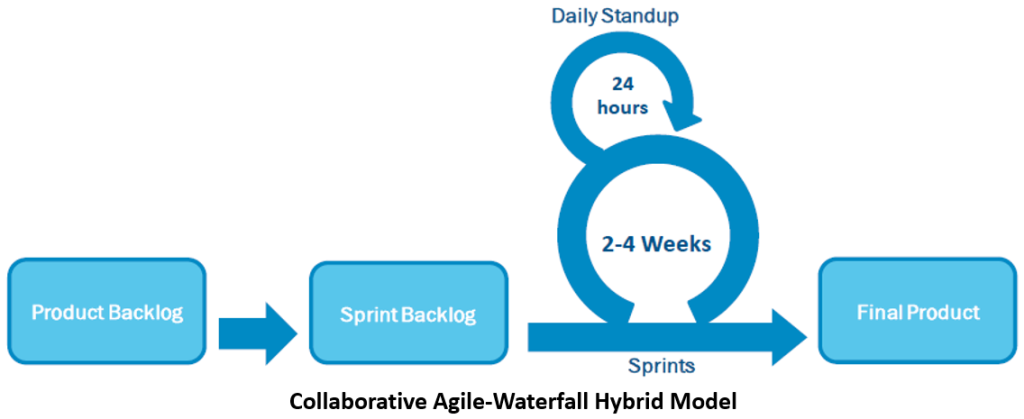October 4, 2016 - by Synoptek
As a software development project manager, you might frequently experience long development cycles, constantly changing requirements (and priorities) that disrupt the development process, and in the worst case scenario, finally deliver a product that does not meet customers’ expectations. Building innovative and quality software solutions on time and within budget is daunting and necessitates the need for a paradigm shift in the way software is developed and deployed.
Although traditional methods of software development like waterfall and more recently, agile, have worked just fine for decades, as technology, markets, and business (or customer) demands evolve, there is a pressing need to build software products that are not only technologically competent, but also help in reducing costs and improving time to market.

Explore why software development companies should leverage both the waterfall and agile approaches to ensure a robust end-product, picking the advantages of both models with our eBook.
What are the Differences Between Agile and Waterfall?
Over the years, several different frameworks have been used to structure, plan, and execute the process of software development. Due to its simple-to-understand and easy-to-use nature, the waterfall model was originally the ideal choice for software development in many companies.
However, over time, software developers could see through the loopholes that existed in the model: the waterfall model was a bad choice for long and ongoing projects where requirements changed frequently (which is inevitable in software development). That’s when the increasingly popular agile was introduced, as it helped CIOs overcome the deficiencies that existed in the waterfall model.
The agile framework offers several benefits like improved agility, flexibility, adaptability, and most importantly, improved software quality due to its incremental nature. However, agile came with its own set of drawbacks including less predictability, extensive user involvement, and lack of necessary documentation for future reference, as noted by Inc.com.
Can Waterfall and Agile Be Used Together?
While both the waterfall and agile methods of software development were extensively used independently, together they have the capabilities to revolutionize the software development process. The Agile-Waterfall Hybrid Model offers the best of both worlds; early and frequent communication in the software development project, and detailed requirements gathering, analysis, design, and documentation.
The end result? A robust end-product that retains the clarity of the waterfall model and preserves the necessary transparency and flexibility of the agile framework to adapt to fast evolving requirements and delivering enterprise-class systems.
What is an Agile-Waterfall Hybrid Approach?
Let’s look at what makes the Agile-Waterfall model such a popular and successful framework:
-
Responsiveness to Change:
Continuous integration between both the models from the concept stage to production provides a high-level of control of the product lifecycle. Synchronization of programs, scenarios, and teams throughout the software development process offers better responsiveness to change; your development team can respond to the unpredictability of software development and adapt to emerging and evolving requirements in time.
-
Continuous Communication:
Communication is key for successful software development. The hybrid model ensures extensive communication between the customer and the development team throughout the software development process. Since communication is fixed early on, you can benefit from a smooth development.
-
Flexibility:
The hybrid model makes sure there is a formal documentation process right at the beginning but also offers the required flexibility to make course corrections all along the way. Since the hybrid model takes an interactive, incremental approach to software development, any customizations or changes that need to be included can be done seamlessly at the appropriate stage.
-
Quick Releases:
The Agile-Waterfall Hybrid Model allows for strong requirements definition and faster iteration with subsequent user feedback that can be simultaneously worked into the development process. By getting instant feedback from different development teams and the customer on what you are developing, you can support frequent releases, and deliver working software in weeks (rather than months).
-
Reusable Code:
The Agile-Waterfall Hybrid Model works best when you want to reuse software code, for developing similar products and/or for building subsequent products. Since a quick turnaround time is key to keep pace with new product releases, reusable code helps achieve the much needed time and cost efficiency.
Better Together
The agile and waterfall models in isolation have worked impeccably in some cases and have failed miserably in others. By embracing the Agile-Waterfall Hybrid Model, you can reduce the chances of failure and enjoy benefits like improved transparency, and agility that not only leads to improved quality but also faster time to market. Just like wine and cheese, some things are just better together!
Schedule a meeting with one of experts today to discuss how the Agile-Waterfall Hybrid Model can improve your software development process.

